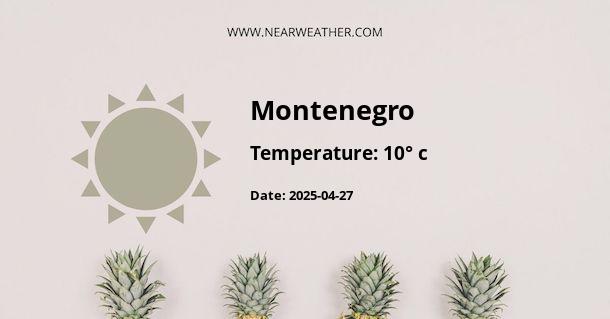Climate and Weather Characteristics of Montenegro
Montenegro, a small yet spectacular country located in Southeastern Europe on the Adriatic Sea, boasts a varied climate thanks to its complex topography and coastal location. Understanding Montenegro's climate and weather patterns is key for anyone looking to visit, invest, or engage in activities that are weather-dependent, such as agriculture or tourism.
Geographical Influence on Montenegro's Climate
The geography of Montenegro plays a crucial role in shaping its climate zones. The country can be split into two primary climatic regions: the coastal area, which experiences a Mediterranean climate, and the interior, which experiences a continental climate.
Mediterranean Climate Zone – Coastal Area
- Warm and dry summers
- Mild and wet winters
- High levels of sunshine year-round
Along the Adriatic coast, the average summertime temperature hovers around 27°C (80.6°F), though temperatures can sometimes climb to over 30°C (86°F). Winters are mild, with average temperatures in January staying around 7°C (44.6°F). The city of Kotor, for example, is a renowned coastal destination that showcases this temperate climate.
Continental Climate Zone – Interior Regions
- Hot summers and cold winters
- Greater temperature variations
- Snowfall is common in the winter months
The interior of Montenegro, particularly areas at higher altitudes, experiences a more continental climate with hot summers and cold winters. In the northern highlands, summer temperatures can exceed 20°C (68°F), while winter temperatures often drop below freezing, with copious snowfall ideal for winter sports.
Seasonal Weather Patterns in Montenegro
Spring
Spring in Montenegro is marked by a gradual increase in temperatures and a decrease in precipitation. It is a time when the natural world begins to bloom, making it a great period for outdoor activities. However, weather can still be unpredictable with occasional showers.
Summer
The summer months, from June to August, are characterized by hot and sunny weather, especially along the coast. This is peak tourist season when the coastal towns come alive with festivals and events.
Autumn
Autumns are generally pleasant with mild temperatures. The weather gradually cools down and the foliage in the mountainous regions offers a beautiful display, although rainfall begins to increase.
Winter
Winters are distinct between the coast and the interior. While coastal areas remain relatively mild and wet, the interior can experience harsh and snowy conditions, with temperatures frequently dropping below zero.
Annual Temperature and Precipitation Overview
| Month | Coast (°C) | Interior (°C) | Coast (mm) | Interior (mm) |
|---|---|---|---|---|
| January | 7-13 | -2-5 | 192 | 155 |
| February | 8-14 | 0-7 | 167 | 147 |
It is important to note that mountainous regions of Montenegro can have varying conditions not entirely represented in the table. Data represents general trends in temperature and precipitation for coastal and interior areas.
Extreme Weather Events and Climate Risks
Montenegro, similar to other countries around the world, is not immune to extreme weather events and the impacts of climate change. These are some of the climatic challenges facing Montenegro:
- Forest fires during prolonged dry seasons, especially in coastal areas
- Flash floods and landslides caused by heavy rainfall in short periods
- Increased frequency of extreme weather patterns due to global climate change
Long-Term Climate Change Projections for Montenegro
The country is actively working on adaptation and mitigation strategies to handle the adverse effects of climate change. Studies indicate that Montenegro could experience:
- A rise in average temperatures
- Alteration in precipitation patterns
- An increase in the frequency of extreme weather events
Useful Meteorological Resources for Montenegro
For updated weather forecasts and climate data, the following resources can be consulted:
- Hydrometeorological Institute of Montenegro (official government weather service)
- European Centre for Medium-Range Weather Forecasts (ECMWF)
- World Meteorological Organization (WMO)
Best Time to Visit Montenegro
Depending on what you're seeking, Montenegro offers different experiences throughout the year. For beach-goers and lovers of the coastal vibe, the best time to visit would be between June and September. For skiing and winter sports enthusiasts, the period from December to March in the northern regions, such as Kolašin and Žabljak, would be ideal.
Implications for Industries and Activities
The variegated climate across Montenegro has direct implications for various sectors:
- Tourism: Summertime coastal tourism versus wintertime mountain tourism are both thriving due to distinct seasonal weather patterns.
- Agriculture: The Mediterranean climate supports the cultivation of olives, grapes, and a variety of fruits, while the interior regions with their cooler climate favor other types of crops and livestock.
- Marine Activities: The Adriatic coast provides favorable conditions for sailing, fishing, and maritime trade year-round.
Montenegro's climate and weather patterns contribute significantly to its diverse natural beauty and thriving industries, making it a year-round destination with various attractions based on the season. Whether one seeks the summer sun on its idyllic beaches or the silent solitude of its snow-capped mountains, Montenegro offers a picturesque canvas that changes its hues with the seasons.
A - Montenegro's Latitude is 42.500000 & Longitude is 19.299999.
A - Weather in Montenegro is -1° today.
A - Climate Conditions in Montenegro shows overcast clouds today.
A - Humidity in Montenegro is 87% today.
A - Wind speed in Montenegro is 5.54 km/h, flowing at 220° wind direction. today.
